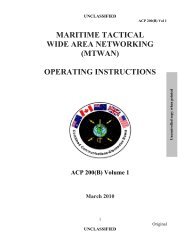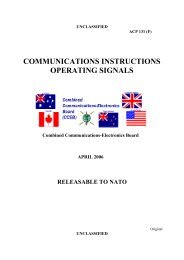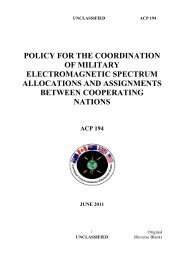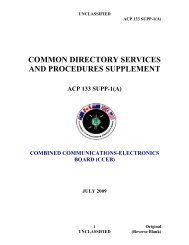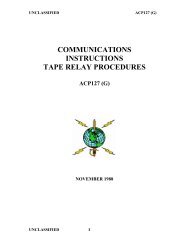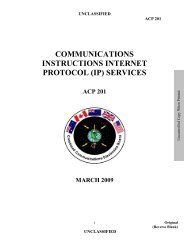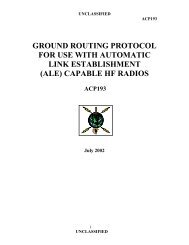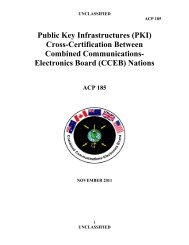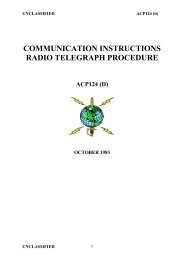MARITIME TACTICAL WIDE AREA NETWORKING (MTWAN ...
MARITIME TACTICAL WIDE AREA NETWORKING (MTWAN ...
MARITIME TACTICAL WIDE AREA NETWORKING (MTWAN ...
- No tags were found...
Create successful ePaper yourself
Turn your PDF publications into a flip-book with our unique Google optimized e-Paper software.
Uncontrolled copy when printedUNCLASSIFIEDACP 200(B) Vol 2213. This effect is easy to understand intuitively: the rate of work that can be performed bya client-server application that executes serialized steps to accomplish its tasks is inverselyproportional to the round-trip time between the client and the server. If the client-serverapplication is bottlenecked in a serialized computation (i.e., it is "chatty"), then increasing theround-trip time by a factor of two causes the throughput to decrease by a factor of two – ittakes twice as long to perform each step (while the client waits for the server and vice versa).214. More generally, the throughput of client-server applications that are not ―chatty‖ butrun over a window-based protocol (like TCP) can also suffer a similar fate. This can bemodeled with a simple equation that accounts for the round-trip time (RTT) and the protocolwindow (W). The window is how much the sender can transmit before receivingacknowledgement from the receiver. Once a window's worth of data is sent, the sender mustwait until it hears from the receiver. Since it takes a round-trip time to receive theacknowledgement from the receiver, the rate at which data can be sent is simply the windowsize divided by the round trip time: T= W / RTT.TCP CONGESTION CONTROL215. Secondly, an additional constraint on throughput has to do with the congestioncontrol algorithm designed into TCP. This flaw can be significant even in WANs wherebandwidth is above a few megabits and is probably the key reason why one often fails to seemarked performance improvements of individual applications after bandwidth is substantiallyincreased. This effect is so dramatic that at 100ms of delay (i.e. a typical cross country link);TCP is able to use only 4.5 Mbps of a 45 Mbps link.CONTROLLING LESS URGENT TRAFFIC216. Large packets delivered from lower priority, high bandwidth applications may affectthe latency for higher priority, latency intolerant applications (such as voice). For example, a1500-byte packet delivered as part of a file transfer over a 64-Kbps link will take 187 ms to betransmitted. This means a voice packet cannot be transmitted during this interval. As a result,voice cuts or delays will be heard for voice traffic queued behind this large packet.217. Different speed links in the network may mean that packets may get queued internallyin the network. When packets queue internally in the backbone of a network, latency andquality can be affected.218. Subsequently, it is important to regulate less urgent traffic (such as Personal E-mailand internet access).OBJECTIVE219. The objective of QoS is to achieve end-to-end predictability of IP packet delivery forCommand through:a. Visibility of the WAN connection;2-3 OriginalUNCLASSIFIED




